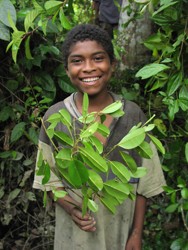
Scientists consider the Bajo Mira area, located on Colombia’s Pacific coast, as one of the world’s richest biological “hot zone” habitats. Home to a variety of plant and animal species, illegal logging practices seriously threatened the ecosystem. Recognizing that it was important to protect this rare ecological area, the nearby communities — Bajo Mira and Frontera — united to find a solution. On August 23, 2005, they formally established their own Community Forestry Enterprise. Representing 53 different small settlements and villages and 6,200 people who live along the Mira River, the enterprise took responsibility for managing 23,971 acres of collectively-owned natural forests.
Working with the USAID-funded Colombia Forestry Program, created to conserve and manage forests like these, the residents of Bajo Mira and Frontera established a plan of action. Their goals were to maximize economic gain from natural forests and protect the habitat for the future. In addition to putting into place strategies to ensure future biodiversity, the 1,606 families in the Bajo Mira/Frontera communities collectively developed internal regulations governing how they use their lands.
USAID also helped the communities develop and implement an assessment of current forestry practices. Each community held workshops to discuss and clarify issues such as rules for using private and communally owned land as well as the community’s vision for future resource management.
The program has been a success and is setting standards for the way other communities deal with natural resources in Colombia. In fact, the Bajo Mira and Frontera communities are the first on Colombia’s Pacific coast to have developed internal regulations for use of natural and forestry resources. With assistance from USAID, the residents of Bajo Mira and Frontera are developing a higher standard of living and a sustainable and brighter future.







Comment
Make a general inquiry or suggest an improvement.